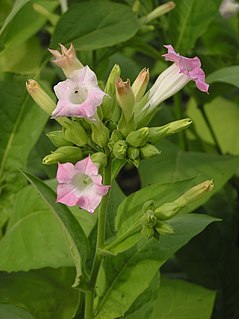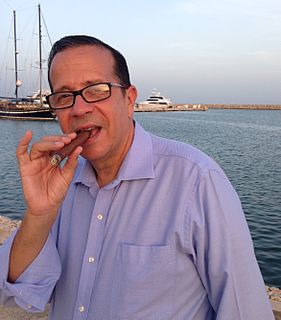Description
While the variety of tobacco, climate, and soil type affect the strength and flavor of tobacco smoke, another key variable is the part of the plant from which the leaves are harvested. [1] The leaves of a tobacco plant ripen from the bottom to the top and are harvested in a series of "primings" as they become ready. [2] As successive layers of leaves are picked and time passes, nutrients concentrate in the slowest ripening leaves remaining at the top of the plant, resulting in the strongest and most flavorful cigar tobacco. [3]

This article includes a list of tobacco cultivars and varieties.

On Earth, interactions between the five parts of the climate system that produce daily weather and long-term averages of weather are called "climate". Some of the meteorological variables that are commonly measured are temperature, humidity, atmospheric pressure, wind, and precipitation. The climate of a location is affected by its latitude, terrain, and altitude, as well as nearby water bodies and their currents.
A soil type is a taxonomic unit in soil science. All soils that share a certain set of well-defined properties form a distinctive soil type. Soil type is a technical term of soil classification, the science that deals with the systematic categorization of soils. Every soil of the world belongs to a certain soil type. Soil type is an abstract term. In nature, you will not find soil types. You will find soils that belong to a certain soil type.
Third-generation cigarmaker Carlos Fuente, Jr. has observed that traditional Cuban tobacco farming was a slow process which allowed for the full development of the spicy ligero leaf.
"…The top leaves are left to overripen, and it looks ugly as hell… And that's what gives you your baritone, heavy flavor, more body. It gives you more complexity." [4]
Extended direct exposure to the sun is a chief contributing factor to the thickened texture and fuller flavor of ligero leaves. [5] As ligero leaves tend to be thicker and oilier, they burn with more difficulty than other tobacco leaves. They are consequently rolled into the very center of the filler bundle of the cigar, so that ignition can be maintained by the lighter surrounding leaf. [6]

Cigar Aficionado is an American magazine that is dedicated to the world of cigars. Published since September 1992, the magazine is known for its articles about different brands of cigars worldwide, and for the celebrities that have appeared on its cover. It is also noted for its opposition to the Cuban embargo. The magazine was launched by Marvin R. Shanken's M. Shanken Communications, the publisher of Wine Spectator magazine since 1976. The current editor is David Savona.

Nicotiana tabacum, or cultivated tobacco, is an annually-grown herbaceous plant. It is found only in cultivation, where it is the most commonly grown of all plants in the genus Nicotiana, and its leaves are commercially grown in many countries to be processed into tobacco. It grows to heights between 1 and 2 meters. Research is ongoing into its ancestry among wild Nicotiana species, but it is believed to be a hybrid of Nicotiana sylvestris, Nicotiana tomentosiformis, and possibly Nicotiana otophora.

Arturo Fuente is a brand of cigar, founded by Arturo Fuente, Sr. in 1912 in West Tampa, Florida. Following a catastrophic fire in 1924, the brand ceased production for 22 years, reemerging in 1946 on a limited, local basis. Ownership was transferred to Arturo's younger son, Carlos Fuente, Sr. in 1958. Following the 1960 United States embargo of Cuba, the Fuente brand began a period of slow and steady growth, emerging as one of the most critically acclaimed makers of hand-rolled premium cigars outside of Cuba. As of 2010 the company was producing 30 million cigars per annum from its factory in the Dominican Republic.
Quintero is the name of two brands of premium cigar, the original produced on the island of Cuba for Habanos SA, the Cuban state-owned tobacco company, and an unrelated line from Nicaraguan and Honduran tobacco produced for the Franco-Spanish tobacco monopoly Altadis SA, now a division of Imperial Tobacco.
Perique is a type of tobacco from Saint James Parish, Louisiana, known for its strong, powerful, and fruity aroma. When the Acadians made their way into this region in 1776, the Choctaw and Chickasaw tribes were cultivating a variety of tobacco with a distinctive flavor. A farmer named Pierre Chenet is credited with first turning this local tobacco into what is now known as Perique in 1824 through the labor-intensive technique of pressure-fermentation. The Tobacco Institute says perique has been shipped out of New Orleans for more than 250 years and is considered to be one of America's first export crops.

Tatuaje is a brand of handmade premium cigar owned by Tatuaje Cigars, Inc. It was created by Pete Johnson in close consultation with José Garcia and is manufactured at the El Rey de los Habanos factory in Miami, Florida, and at Tabacalera Cubana S. A. (TACUBA) in Estelí, Nicaragua.
EO Premium 601 Serie is a brand of handmade premium cigar owned by EO Brands/United Tobacco.

Diamond Crown Maximus is a super premium cigar brand handmade by Tabacalera A. Fuente in the Dominican Republic for the J.C. Newman Cigar Company.

Tobacco is the agricultural product of the leaves of plants in the genus Nicotiana. All species of Nicotiana contain the addictive drug nicotine—a stimulant and sedative contained in all parts of the plants except the seeds—which occurs in varying amounts depending on the species and variety cultivated. See types of tobacco and curing of tobacco for more information.

The cultivation of tobacco usually takes place annually. The tobacco is germinated in cold frames or hotbeds and then transplanted to the field until it matures. It is grown in warm climates with rich, well-drained soil. About 4.2 million hectares of tobacco were under cultivation worldwide in 2000, yielding over seven million tonnes of tobacco.

It is necessary to cure tobacco after harvesting and before it can be consumed. Tobacco curing is also known as color curing, because tobacco leaves are cured with the intention of changing their color and reducing their chlorophyll content.

A cigar cutter is a mechanical device designed to cut one end off a cigar so that it may be properly smoked. Although some cigars are cut on both ends, or twirled at both ends, the vast majority come with one straight cut end and one end in a "cap" which must be cut off for the cigar to be smoked. Most quality handmade cigars, regardless of shape, will have a cap which is one or more small pieces of a wrapper pasted onto one end of the cigar with either a natural tobacco paste or with a mixture of flour and water. The cap end of a cigar is the rounded end without the tobacco exposed, and this is the end one should always cut. The cap may be cut with a knife or bitten off, but if the cap is cut jaggedly or without care, the end of the cigar will not burn evenly and smokeable tobacco will be lost.
La Flor Dominicana is a "boutique-style" cigar brand manufactured by Tabacalera La Flor S.A., a company started in 1996 in Santiago, the Dominican Republic. The company was started and is currently owned by cigar maker Litto Gomez Diez, who was called by Cigar Aficionado "arguably the most innovative mind in the cigar business." Gomez, a jeweler-turned-cigar maker started the business after his jewellery store in Miami was robbed by armed men at gunpoint of about $400,000 worth of jewellery. Today the company's factory is based in Tamboril, in the Dominican Republic.
Oliva Cigar Co. the manufacturer of several brands of cigars primarily grown and produced in Nicaragua and sold worldwide. The family-owned company traces its roots to patriarch Melanio Oliva, who began growing tobacco in Pinar del Río, Cuba in 1886. In 1964, in the aftermath of the 1959 Cuban Revolution, Melanio's grandson Gilberto Oliva emigrated with his family to Spain before eventually moving to Nicaragua and reentering the tobacco business. In 1995 Gilberto and his son, Gilberto Jr., launched the "Gilberto Oliva" brand — a label which evolved into today's Oliva. The company is based today in Miami Lakes, Florida.
The Cigar Boom is the name given to the resurgence of cigar consumption in the United States during the mid-1990s. Beginning in 1992, imports and sales of premium cigars began to rise dramatically and manufacturers struggled to keep up with demand, leading to industry-wide shortages of raw materials and finished products. The period was marked and the trend accelerated with the 1992 establishment of Cigar Aficionado magazine.

José Blanco is the former Senior Vice President of the oldest Nicaraguan cigar company, Joya de Nicaragua S.A., in Estelí, Nicaragua, and the former Sales Director of La Aurora, the oldest Dominican cigar company in Santiago, Dominican Republic. He is a master blender of cigars who is renowned not only for those skills but for his tasting seminars, in which he educates cigar consumers on the intricacies of cigar construction, tobacco blending, and taste.

Boutique Blends Cigars, formerly the Habana Cuba Cigar Company, is an American manufacturer of premium hand-rolled cigars based in Miami, Florida. The company was established in 1996 during the American cigar boom as the non-Cuban manufacturer of the historic Cuban "Oliveros" brand. The company was sold in 2002 to a new ownership group consisting of the Cuban-born Rafael Nodal ; his wife Alina Cordoves Nodal, and Hank Bischoff.













